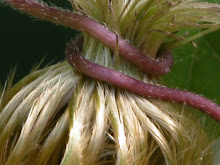Day 7 – Friday - Gardens
Observations on Belgium/Belgians … things I -- a native pacific northwestern United States born average-aged person -- did not notice right away. It’s sunk in slowly while motoring the back roads near where long-dead famous artists once lived. Flat landscapes of muted blues and faded yellows under gunmetal blue skies. Most people, most cars, most buildings are dressed in somber black, gray, dark blue, silver, white. It’s unusual to see a gold car or someone wearing bright clothing.

Being a gardener, I naturally notice gardens -- like an avid garage-saler who causes traffic tie-ups rubbernecking the items laid out for sale on someone’s driveway. And what I notice here is that same muted and somberness spills out into the gardens. When there ARE gardens. Color interest now (mid-September) seems to come from white hydrangeas, the ubiquitous red geranium, lots of ornamental grasses and green shrubs. A Japanese maple just starting to put on its fall color surprises me here and there and puts a lie to this generalization of dull colors. And here is a photo of one garden I saw that made me say, “Stop the car!”
Outside the city, trimmed evergreen hedges abound. Green SpongeBob SquarePants guardrails separate homes from zooming cars. Lots of everything is sheared into forms alongside the roads, up the walls, and in the small front yards with little patches of lawn. Box, yew, juniper and cypress transformed from nature into formal hedges, topiary and standards. People generally use mass plantings in miniature places. Dwarf trimmed box hedges line tidy-with-barely-a-pebble-out-of-place gravel pathways. London Plane trees with their peculiar odor and flaking gray bark survive to a large size here and there, alongside blue Atlas cedar, juniper, pine, elm, chestnut, and espaliered fruit trees. In the cities, the tall narrow homes, packed together like sardines, open right up to the narrow sidewalk so few trees or flowers seem even possible.

One morning after breakfast I stumble across the Gent flower market and crutch my way through, checking out the plants. Mostly commodity-type plants, but still ones I have not seen in people’s yards. Cyclamen, heather, heavenly bamboo, palms, asters, and a large assortment of clipped evergreens, ready to pop into the ground.
So I wonder, where do Belgiums garden? What’s growing in their backyards?!? Do their somber facades of face and garden open up to colorful personalities dressed in gold clothing and interesting private gardens? I believe so.
Plant geek comment: at the flower market I was surprised to find a cultivar of the red-berried groundcover Bearberry (Arctostaphylos uva-ursi) that is native to my hometown. The native Americans ate the berries and smoked the leaves. It is also called kinnikinnick, mealberry, upland cranberry, rhamnus purshiana, aconitum napellus, aconite, bear’s-food, friar’s-cap, helmet-flower, luckie’s mutch, monkshood, soldier’s-cap, turk’s-cap, arberry, mountain cranberry, and uva-ursi.




